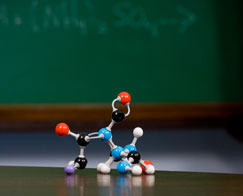Heat Transfer in a Mixture
This lesson plan can also be downloaded: Word, PDF.
Time required
Approximately 30-40 minutes. 10-15 minutes of teacher prep time.
Objective
Heat flows predictably from hot to cold, eventually reaching an equilibrium temperature.
Materials
- 2 beakers or Styrofoam cups
- 2 equal masses of water at different temperatures, initially less than half of the capacity of the beakers
- 2 Celsius thermometers that measure from 10 to 100 degrees, or electronic temperature probes with a least the same range
- Clock or stopwatch
Procedure
This should be done as a discovery lab.
- Set up the two samples of water at different temperatures and tell students they have the same mass. Measure and record the initial temperature on the worksheet.Ask the Students: What will happen when they are mixed? Specifically, what will happen to the temperature of the mixture? Does anyone want to guess at the exact temperature of the mixture when they are mixed?
- Mix the two samples together and measure the temperature of the mixture every 30-60 seconds, recording the measurement on the worksheet. Students may track and graph the data in any way that you see fit, including using a graphing calculator or spreadsheet.
- Repeat the above procedure for equal amounts of a different substance, such as rubbing alcohol.
- Repeat the above for unequal amounts of water.
- Repeat the above for unequal amounts of a second substance.
The above steps could be assigned to groups to carry out the experiment and then report their results to the class.
Ask the Students:
- Suppose that we had 327 grams of liquid nitrogen at -200°C and 327 grams of liquid nitrogen at -208°C. What would the final temperature of this mixture be? (Interesting trivia: Liquid nitrogen has a melting point of -210°C and a boiling point of -196°C which is only a difference of 14°C!)
- Suppose that liquid helium at 2 K were mixed with an equal amount of liquid helium at 4 K. What would the final temperature of the mixture be? According to Dr. Kevin Boyce of the Suzaku team, the spacecraft itself reaches temperatures of 240 K to 360 K – note that 300K is approximately room temperature. It is an extreme challenge to drop the temperatures to the 0.06 K needed for the XRS (X-ray spectrometer) to work properly!
Extra Credit/Extension
The temperature of space itself is at approximately 3 K (see, for example, Temperature in Space), which is extremely warm compared to the very cold 0.06K needed for the operation of the XRS on board the Suzaku satellite. Why space is not at absolute zero (0 K), and what this fact has to do with the age of our Universe?

Teacher's Corner